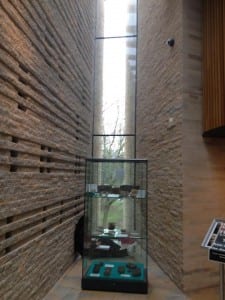From our first impressions of ‘The Collection’ it is apparent that there are a large number of spaces, both large and small, that a “Professional stranger” (Govan 2007, p122) can interact with and view with a fresh outsiders perspective.
We began to look at conventional ‘spaces’ from the site such as:
and
However we found these to be too stereotypical of an actual theatre space, although their architecture was intricate, interesting and very abstract. We then decided to look at the places within ‘The Collection’ which were less obvious:
Here we can see even the structure of the building itself poses abstract and interesting thoughts to us as performers. The architecture of the walls continue past the window, instead of the window framing the building. Also the display cabinet is not pushed up against the window which in turn creates an unnoticed and empty space. (modeled beautifully by Sam!).
We sat in this space and listened to the environment around us which was surprisingly loud and vibrant considering a museum is a space for thinking and observing. This small space was filled with the echos of conversations, footsteps and even voices coming from the wall itself. The sound wall stretched across the width of the building with speakers positioned along it; however some of the speakers were hidden in the small, apparently unused space that we occupied behind the cabinet. Which poses the question, why are there speakers placed in an area unused and unnoticed by the public?
From this we are starting to look at the museum’s potential as a performing space and the usual places that are unknown to a stranger’s eye and are asking ourselves, what could happen there?…
Works Cited
Govan, Emma and Helen Nicholson and Katie Normington (2007) Making A Performance: Devising Histories and Contemporary Practise. Routledge: London
![DSC_0026[1]](https://sitespecific2013dhu.blogs.lincoln.ac.uk/files/2013/01/DSC_00261-300x65.jpg)

